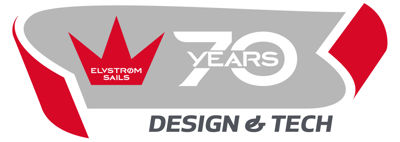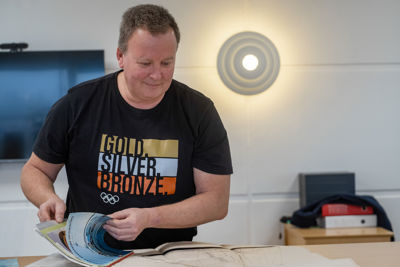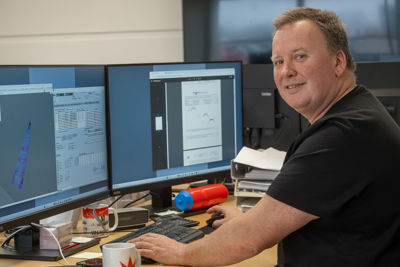


Sometimes, old photos show up in company with a good story. This is indeed the story about this photo from the 40th anniversary of Elvstrøm Sails. And with the company turning 70 this year, it only felt fitting to have a chat with one, who is not only on the 30 year old photo, but just as importantly still is a part of Elvstrøm Sails today.
To our designer Torsten Havemann, this picture is an important memory with the company. And even today, it features three guys who are still involved in Elvstrøm Sails. Alongside Torsten, it features Jesper Bank and Flemming Christensen. Christensen is our Research and Development Manager, and Jesper Bank is currently running Elvstrøm Sails Palma, Mallorca.
- All of us got a copy of this image made as a part of the 40 Years anniversary celebrations. It’s me, Jesper and Flemming on the top row, and alongside Paul, it’s Keld Larsen and Henrik Voss. I was in the design department with Keld and Henrik, while Flemming and Jesper were in charge of the development at that time. Jesper was also right in the middle of his competitive racing in the Soling, which led him to win the Olympics twice in 1992 and 2000.
- Paul was a keen visitor at the loft and he often came to say hi – and although he was mostly here as a guest, he just couldn’t stop thinking of new ideas and solutions. This is why I have fond memories of these years as it was a constant source of ideas and inspiration that helped form Elvstrøm Sails.

Joining Elvstrøm Sails
Torsten joined Elvstrøm Sails in 1990, and only a couple of years later, he switched from being a sailmaker at the loft to become a designer. His background in racing just about anything and everything with sails since the age of six came in handy – and having the chance to learn from Mr. Elvstrøm himself was the icing on the cake.
- We sailed quite a lot with Paul in various boats at the time. He had a Dragonfly which we spent lots of time with. It was great fun and a huge inspiration for me to see how he approached the tuning and trim of a boat. No matter what, he would never stop looking for small tweaks on the trim of the boat. He would never stop chasing that last tenth of a knot. This is a philosophy I learned a lot from. I was in my 20’s then, and I picked up so many good stories and advice in those years, Torsten says and adds:
- This also underlines why it’s important to get out and see the sails in action. There is always some new inspiration or idea to pick up – no matter if you’re sailing on your own, if you’re racing or simply if you go to a trade show to get a first-hand look at the new trends.

The inspiration
Even long before he actually joined Elvstrøm Sails, Torsten found the big inspiration. Torsten grew up in Aabenraa and picked up sailing very early on. First in the Optimist and Laser - then various other dinghies plus a lot of different keelboats and multihulls.
Yet – no matter what class Torsten Havemann was competing in, the big inspiration was Paul Elvstrøm.
- Ending up working here was probably the way it should be. Elvstrøm Sails moved to Aabenraa when I was a kid. It became a part of growing up here that our town had one of the best sail lofts in Europe, and to me as a young sailor, the story and mentality with which Paul approached sailing was a great inspiration.
And while his classmates mainly had footballers as their idols, Torsten and his sailing friends had someone else:
- Paul was always a part of the game and he kept on chasing further development and innovation in the sport. He made so many great inventions that are a part of sailing today – such as the winchblock, the self-bailer and the swim vest to name a few. And while our classmates wanted to be the next big football player, like Laudrup, Elkjær or Simonsen, us guys in the sailing club only had one idol: Paul. And that was for a number of reasons, Torsten adds:
- Paul’s way of doing things was just inspiring from A to Z. He insisted that races should be won the right way. He never filed a protest – it even cost him an Olympic medal, but he insisted on not protesting. Fair sailing was key to him, and I think it says a lot that you can race and have that view on it. And then he had this very innovative side, which brought so many improvements to all aspects of dinghies and sailboats, and just the fact that his ideas are still in use today really underlines the difference he made.

Design progression
Naturally, the technological progression has had a big say in many industries, and ours sure is one of them. Having joined the company at the very start of the 90’s, Torsten also joined right at the time where the computers made their way in.
It quickly turned in to a technical revolution, Torsten recalls:
- The 90’s was a super interesting time for the company by all means. I joined just at the time where the calculator had been dropped to make way for the first computers in design. I remember that you had time to go and pick up a new cup of coffee when the machine was calculating – but in the end, it really took sail design to a new level. At the time, we had new computers almost twice a year as hardware and software development progressed so quickly. It’s fun to think of it today, but it surely highlights how much our industry progressed at the time.
He adds:
- Better calculations progressed into better machinery and a level of precision we just weren’t used to. When I started as a sailmaker in 1990, we were cutting the sails by hand. Yet, despite years and years of knowledge, you just can’t keep up with either the pace or the precision of a cutting table. And these have of course evolved just as much as our software over the years.

So what does the future hold?
- Had you taken that picture in 1994 and asked us what we thought sailing boats would be like today, 30 years on, I’m sure we wouldn’t have had any idea. In my view, the evolution has happened a little outside the sails – the really visible changes are foils and hull designs. And since the boat design will always stay connected to the way we do the sails, it will also have an influence here.
- It is always difficult to predict the future, but seeing what has happened since I joined the company at the time, where we had just set aside the calculator, it's certainly going to be exciting to see where the industry will go.
